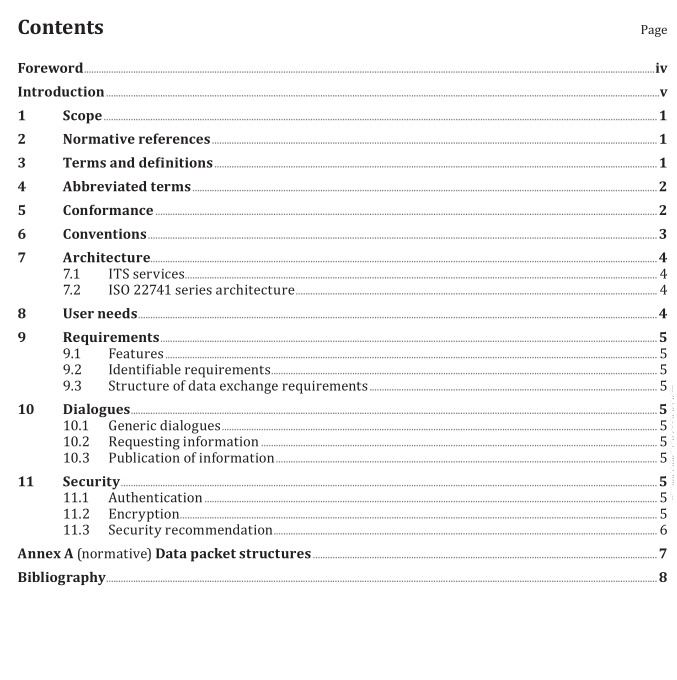ISO 22741-1:2022 pdf download.Intelligent transport systems — Roadside modules AP-DATEX data interface — Part 1: Overview
5 Conformance
Conformance to each part of the ISO 22741 series is defined in the conformance section of each part, which is written using the structure defined in this clause. Conformance is driven by defined user needs. Each part of the ISO 22741 series may define user needs and the design to fulfil the user need. User needs are written from the perspective of a manager for the field device.
NOTE 1 Some parts of the ISO 22741 series do not define any user needs, but only provide reusable design elements that can be referenced by other parts of the series.
Table 1 of each part of the ISO 22741 series (other than this document) identifies the user needs associated with the part and indicates whether they are mandatory or optional for conformance to that part. Each user need is also traced to a set of features. A feature is a high-level, architectural concept that represents a coherent capability of the device that can support multiple user needs.
Table 2 of each part of ISO 22741 (other than this document) traces each feature to the requirements for that feature. Each user need, feature, and requirement are identified by name and a reference. The reference can be within the same part, a different part or a different document.
When references are made to other documents, all details and remaining traceability are defined in the referenced document. Both tables indicate conformance for an item using one of the following conformance codes:
— M – indicates the item is mandatory when an implementation claims conformance to its parent item.
— O – indicates the item is optional when an implementation claims conformance to its parent item and if no other parent item makes the item mandatory. Parent items are defined as follows:
a) The part is the parent item of each user need defined within it.
b) Each user need is a parent item for one or more features as shown by the indentation in Table 1. A user need may trace to multiple features and a feature may trace from multiple user needs.
c) Each feature is a parent item for one or more requirements as shown by the indentation in Table 2. A feature may trace to multiple requirements; a requirement may trace from multiple user needs but typically only traces from one feature.
Note that a feature defined in one part of the ISO 22741 series can have a parent defined in another part. Features should not be defined until at least one user need exists for the feature. A qualifier may precede a conformance code. In such cases, the qualifier shall be a term followed by a colon.
The term shall be defined in Table 3 as a reference to a specific clause in a specific document. The meaning of this notation is that the conformance code only applies when the referenced clause is supported by an implementation. EXAMPLE 1 The code “condition:M” means that the indicated row is “mandatory” if the clause referenced by the term “condition” is supported by the implementation. An option group expression may follow the “O” conformance code. The option group expression will be of the form “.<group> (<multiplicity>)”, where group shall be a sequential number that groups a number of options together and <multiplicity> shall be a range of integers that indicate the number of options that may be supported by an implementation from the option group.
EXAMPLE 2 The code “O,2 (1..*)” means that the indicated row is optional, but one or more options from option group 2 are to be supported. The requirements referenced by Table 2 are written as “shall” statements. However, they are only applicable if the conformance table indicates that the feature is required.
NOTE 2 This document defines the rules to be followed by subsequent parts of the ISO 22741 series; it does not define any user needs or features itself and therefore does not contain Tables 1-3. 6 Conventions This document contains references to and explanations of ASN.1 data concepts within its text. In all cases, the ASN.1 terms are presented in a fixed width font (e.g. such as this ) to distinguish these terms from normal English.ISO 22741-1 pdf download.ISO 22741-1:2022 pdf download
